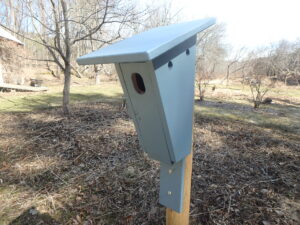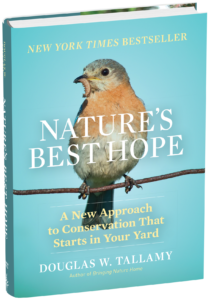How What We Grow Helps Our Feathered Friends – and the Environment
Posted on Tuesday, April 6, 2021 · Leave a Comment
By now birds are finding their own food and have less need for that sunflower seed we have been providing during the cold days of winter. So what can we do to help our birds as they go into the season of having young? Growing native trees and shrubs on our property can be a huge help to our bird friends.

Bird houses are nice but we need to do more for our baby birds including growing native plants
Let me explain. It is not enough to put out birdhouses, we need to help birds find food for their chicks. The diet of baby birds is about 90% composed of caterpillars. Caterpillars – the larvae of Lepidoptera (moths and butterflies) – are high in fat and protein that developing birds need to grow and be healthy. One clutch of chickadees can, according to entomologist Doug Tallamy, a PhD researcher from the University of Delaware, consume 6,000 to 9,000 caterpillars in the 16 days from hatching to fledgling. And most parent birds continue to feed their chicks even after they have fledged.
In Tallamy’s new book, Nature’s Best Hope: A New Approach to Conservation That Starts in Your Yard, he explains that not all trees and shrubs are created equal. Those that evolved alongside the butterflies and moths are palatable to them. Those that were imported from Asia or Europe mostly are not of interest to them.

Nature’s Best Hope
Most woody plants create toxins or bad-tasting chemicals to keep all sorts of animals from eating them, but caterpillars have developed ways to eat most native tree leaves – they have adapted to eat what was available to them. It’s as if they learned to eat things, the way we learned to eat Brussels sprouts.
Although caterpillars eat the leaves of our native plants, they rarely damage or defoliate their host plants. Tent caterpillars and a few other imported species will defoliate trees, but that’s rare. It’s just that most of us never notice the little holes chewed in the leaves that are supporting the caterpillars.
In fact, I rarely notice caterpillars in the trees and shrubs at all – but our bird friends certainly do. They evolved along with the caterpillars and are genetically programmed to recognize them and bring them to their young, even birds that are seed eaters.
As Dr.Tallamy explains in the book, not all native plants are created equal. Some native species may only feed a few. Some, like our oaks, feed many hundreds of species of caterpillars. These “keystone species” are critical to supporting our wildlife. Five percent of the native species support over 70% of our Lepidoptera, according to Tallamy.
So what plants are best to feed the caterpillars that support our birds?
According to Tallamy’s research, native oaks, cherries, willows, birches, poplars and elms are best, and goldenrods, asters and perennial sunflowers “lead the herbaceous pack.” The National Wildlife Federation’s Plant Finder website (
https://www.nwf.org/NativePlantFinder) allows you to enter your zip code and see what plants are best for your zone, and how many pollinators are served by each.
Tallamy did a study in Portland, Oregon and found that of 1176 trees he identified on the streets there, 91.5% of them were from other continents or ecoregions, mainly Asia. What does that mean? Portland is a pretty city with lots of trees, but it is largely a wasteland for caterpillars that feed our baby birds. The birds need to nest where they can get food for their young.

Leaf litter and native plants are better under a tree than lawn
If you wish to improve your landscape and plant native species that will support wildlife, think about reducing lawn size. Tallamy explains that there are 40 million acres of lawn in America, an area the size of New England. Thirty percent of our water is used to water lawns, and 40 to 60% of all fertilizer ends up in our waterways and drinking water, he wrote.
Doug Tallamy proposes that we all join him in creating, a “Homegrown National Park”, by reducing our lawns by 50% and growing native plants. This will create wildlife corridors and improve our environment in many ways. The plants will sequester carbon in ways that lawn does not. It will help to save endangered species of insects and birds. It will reduce pollution of our air and water. Who could argue with such an idea?
According to one study, in newer housing developments lawn covers about 92% of space not covered with driveways and buildings. If we were all willing to reduce our lawns and add trees, shrubs and native perennials, that would make a big difference in helping to reduce species extinction of Lepidoptera, birds and small mammals. It does not require eliminating lawn, just reducing it. Think of lawn as area rugs, not wall-to-wall carpeting.
What else can you do to help our birds? Add a water feature. Even a small pool with a re-circulating pump will attract birds, especially migrating birds that need water and food for their long journey.
Instead of lawn, add native groundcovers. Lawns get compacted by lawnmowers, making it difficult for caterpillars and native bees to burrow in the ground. Most caterpillars pupate in the ground or in leaf litter, but lawns are not suitable. Other than honeybees, most bees burrow into the ground or into decaying wood to lay their eggs and hatch their young.
I love the idea of us all of linking our properties together to support our butterflies and bees. You can go to
www.homegrownnationalpark.org to register your property as part of this movement. Thanks!
Henry is the author of 4 gardening books and a UNH Master gardener. You may reach him at
henry.homeyer@comcast.net or PO Box 364, Cornish Flat, NH 03746.





